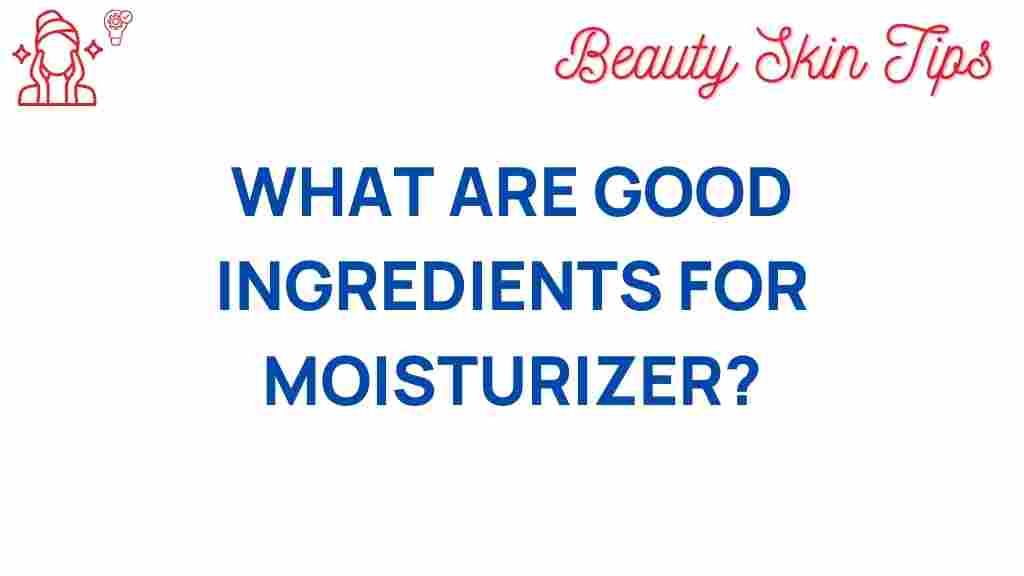Unlocking the Secrets: What Makes a Good Moisturizer Ingredient?
Moisturizers are an essential part of any skincare routine, providing hydration and protection to the skin. However, not all moisturizers are created equal. Understanding what makes a good moisturizer ingredient can help you make informed choices about which products to use. In this article, we will explore the key components of an effective moisturizer and how to select the right one for your skin type.
The Importance of Moisturizers
Moisturizers serve several vital functions for the skin:
- **Hydration**: They help to maintain skin moisture levels, preventing dryness and flakiness.
- **Barrier Protection**: A good moisturizer creates a barrier that protects the skin from environmental stressors.
- **Soothing Properties**: Many moisturizers contain ingredients that can reduce irritation and enhance skin comfort.
- **Anti-Aging Benefits**: Effective moisturizers can help minimize the appearance of fine lines and wrinkles.
To reap these benefits, it is crucial to understand what ingredients contribute to the effectiveness of a moisturizer. Let’s dive into the essential components that make a moisturizer truly effective.
Key Ingredients in a Good Moisturizer
When evaluating moisturizers, look for these key ingredient categories:
1. Humectants
Humectants are substances that attract water to the skin. They are vital for hydration and help keep the skin plump and youthful. Common humectants include:
- Glycerin: A powerful humectant that draws moisture from the environment.
- Hyaluronic Acid: Known for its ability to hold up to 1000 times its weight in water, making it a superstar for hydration.
- Aloe Vera: A natural humectant that also provides soothing properties.
2. Emollients
Emollients are ingredients that soften and smooth the skin. They fill in gaps between skin cells, providing a smoother appearance. Look for the following emollients:
- Shea Butter: Rich in fatty acids, it nourishes and hydrates the skin.
- Cocoa Butter: A thick emollient that creates a protective barrier on the skin.
- Jojoba Oil: Mimics the skin’s natural oils and is excellent for all skin types.
3. Occlusives
Occlusive agents are ingredients that form a barrier on the skin’s surface, preventing moisture loss. They are especially beneficial for dry or dehydrated skin. Key occlusive ingredients include:
- PETROLATUM: A highly effective occlusive that locks in moisture.
- Beeswax: A natural occlusive that provides a protective layer without suffocating the skin.
- Lanolin: An animal-derived occlusive that is great for dry areas.
Choosing the Right Moisturizer for Your Skin Type
Different skin types require different moisturizing ingredients. Here’s how to choose the right moisturizer based on your skin type:
1. Oily Skin
If you have oily skin, look for lightweight, oil-free moisturizers containing:
- Hyaluronic acid
- Glycerin
- Gel-based formulas
2. Dry Skin
For dry skin, opt for rich, creamy moisturizers that include:
- Shea butter
- Cocoa butter
- Occlusives like petrolatum
3. Combination Skin
Combination skin benefits from a balance of lightweight and nourishing ingredients. Look for moisturizers that feature:
- Jojoba oil
- Lightweight creams that hydrate without feeling heavy
4. Sensitive Skin
For sensitive skin, choose products with minimal ingredients and soothing properties, such as:
- Aloe vera
- Chamomile extract
- Fragrance-free formulations
Step-by-Step Process for Selecting a Moisturizer
Choosing the right moisturizer can be a daunting task. Follow these steps to simplify the process:
- Identify Your Skin Type: Determine whether your skin is oily, dry, combination, or sensitive.
- Read the Ingredients List: Look for key ingredients mentioned above that cater to your skin type.
- Consider Your Climate: If you live in a dry climate, opt for richer formulations. In humid climates, lighter gels might be more suitable.
- Patch Test: Always perform a patch test with new products to avoid adverse reactions.
- Consult a Dermatologist: If you have specific skin concerns, seek professional advice for personalized recommendations.
Troubleshooting Common Moisturizer Issues
Even with the best intentions, you may encounter issues while using moisturizers. Here are some common problems and how to troubleshoot them:
1. Greasy Feel
If your moisturizer feels too greasy, consider:
- Switching to a gel-based moisturizer.
- Using a lighter emollient or humectant.
2. Irritation or Breakouts
For irritation or breakouts, try the following:
- Look for non-comedogenic formulas.
- Identify and eliminate any potential allergens.
3. Dryness Despite Moisturizing
If your skin still feels dry after using a moisturizer, consider:
- Incorporating a hydrating serum before applying your moisturizer.
- Using a heavier occlusive layer at night.
For more in-depth skincare tips, you can check out this comprehensive guide to skincare.
Conclusion
Understanding what makes a good moisturizer ingredient is key to achieving healthy, hydrated skin. By focusing on humectants, emollients, and occlusives and tailoring your choices to your skin type, you can unlock the full potential of your skincare routine. Always remember to read ingredient labels, perform patch tests, and consult with professionals when necessary. With the right knowledge and products, you can enjoy beautifully moisturized skin every day!
For additional resources and tips on skincare, feel free to visit our blog for the latest articles and guides.
This article is in the category Ingredients and created by BeautySkinTips Team
